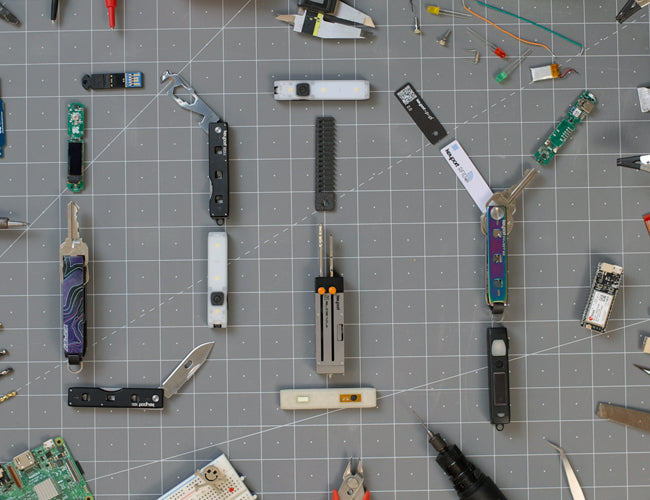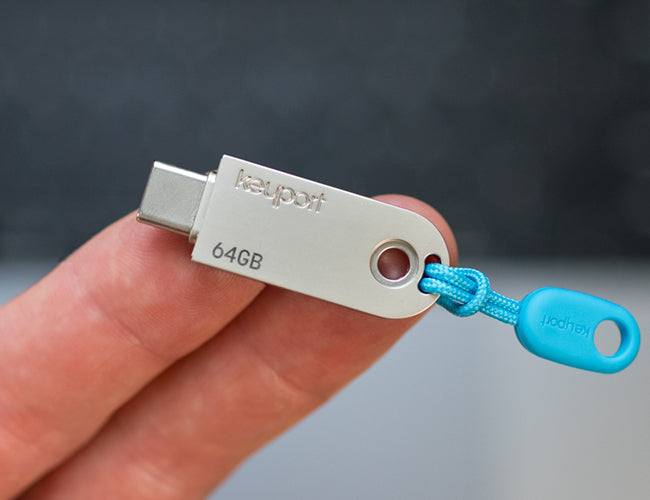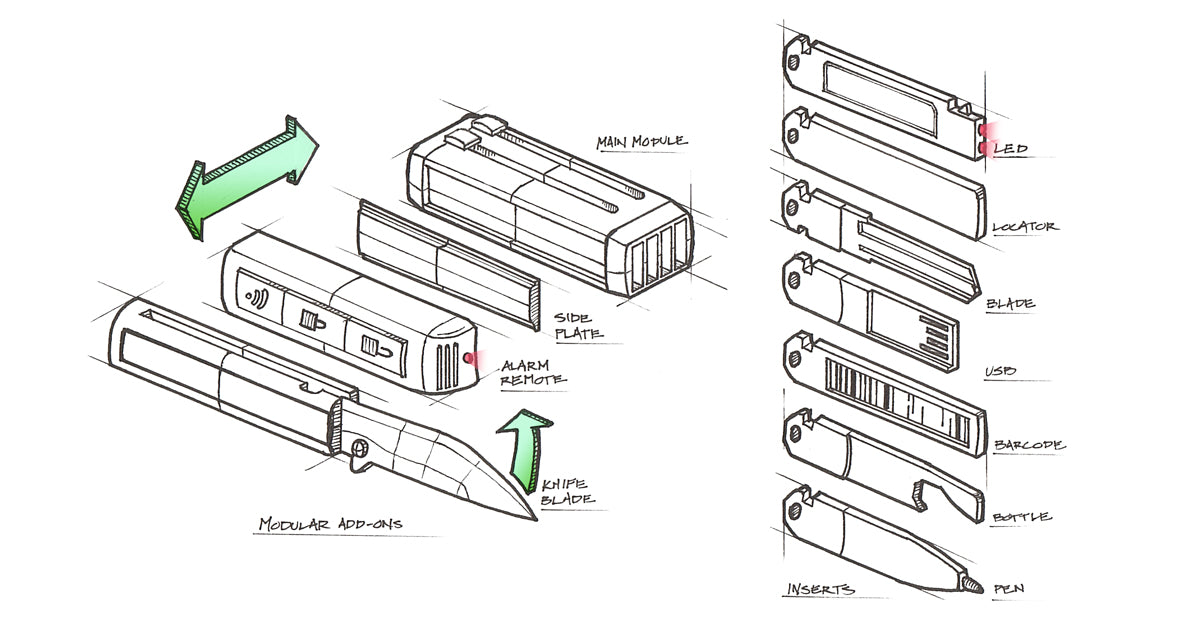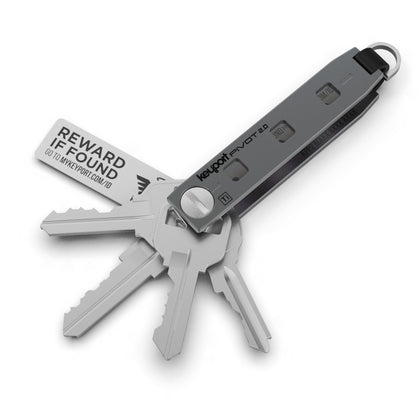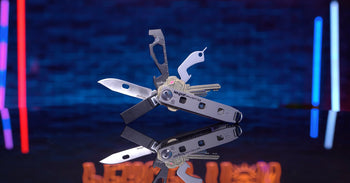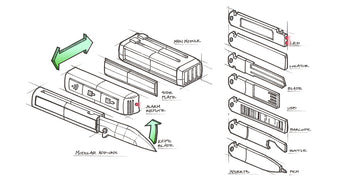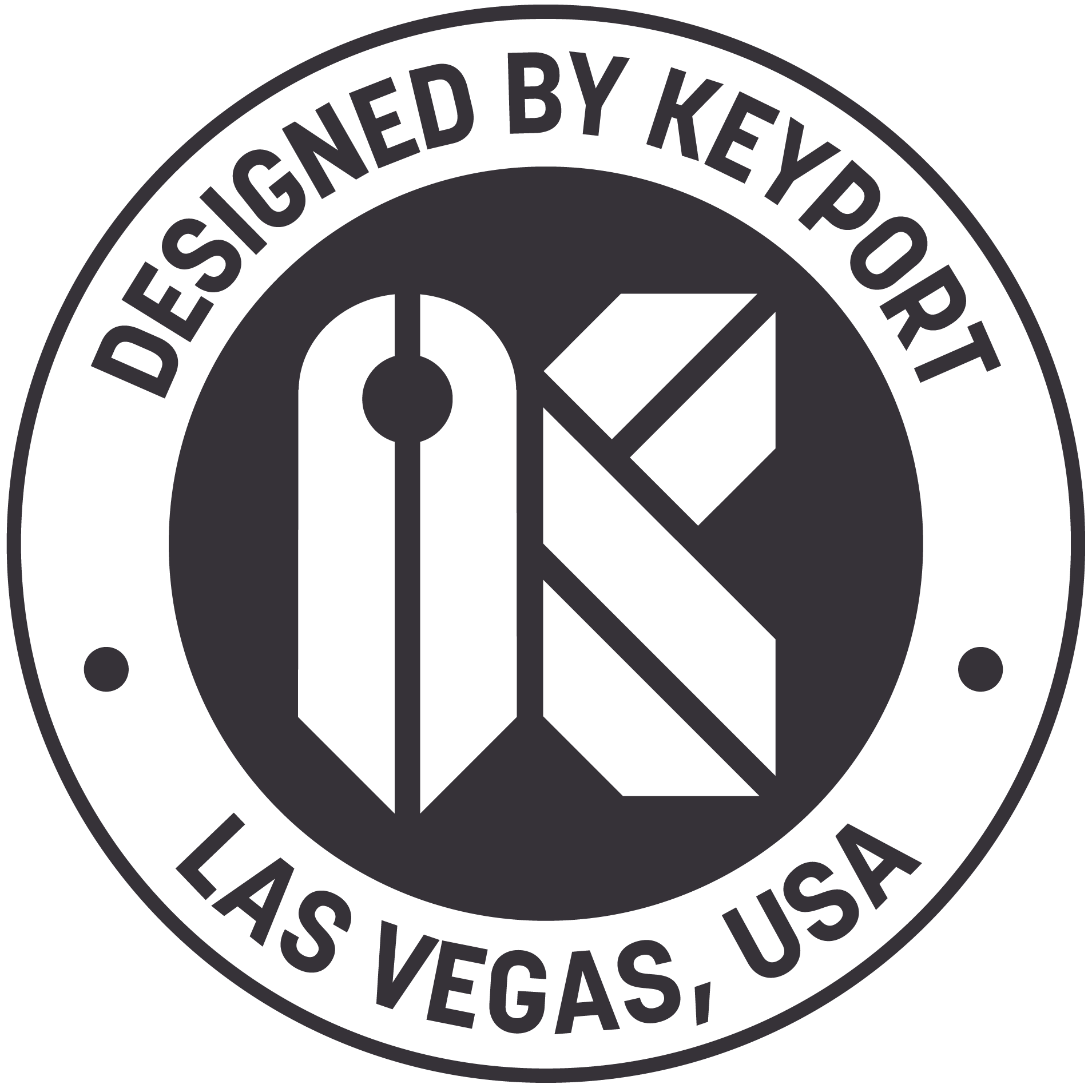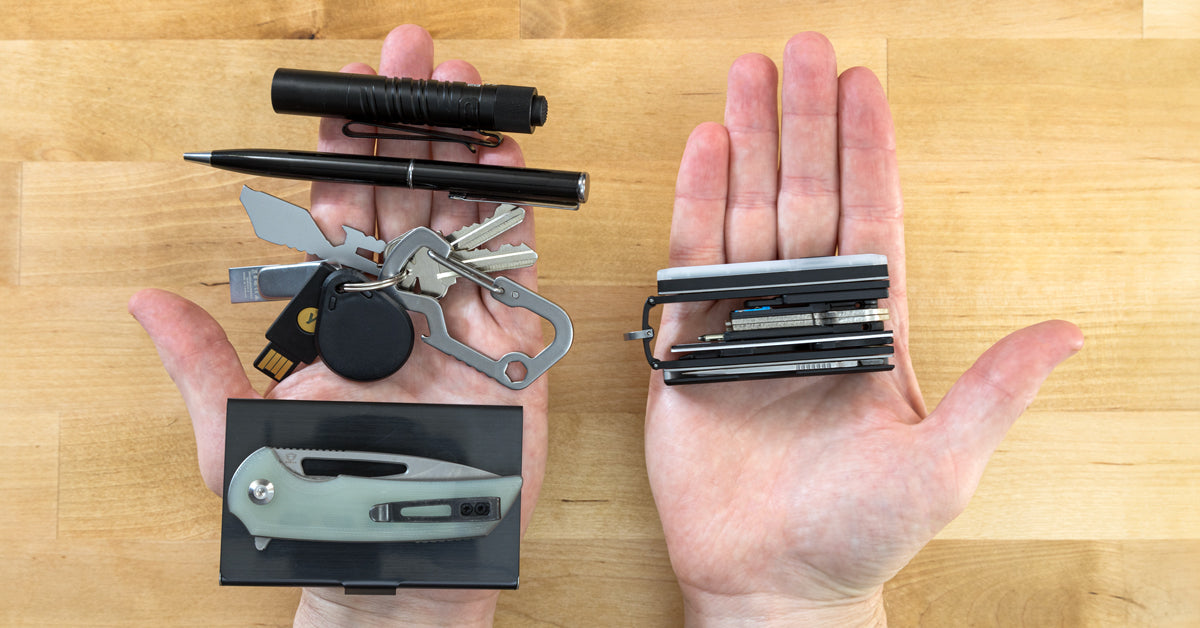

This guide was written by the Keyport team to provide honest comparisons, buyer tips, and insightful answers to readers’ top questions about key organizers.
From Keychain to Key Organizer: Why the Upgrade Is Worth It
In the world of everyday carry (EDC), few debates are as persistent as the one between the old-school keychain and the modern key organizer. One rattles, bulges, and scratches everything in your pocket. The other keeps things streamlined and quiet. For longtime EDC enthusiasts and curious newcomers alike, the shift raises plenty of questions: What exactly is a key organizer? Why does it matter? And how do you choose one that actually fits your life?
Key organizers are not simply about silencing your keys. They represent a shift in how we treat our daily essentials. Just as wallets have slimmed down and phones have evolved into computers, the humble key has found a new home in designs that are smarter, sleeker, and capable of carrying tools right alongside your keys.
At Keyport, we have been part of this evolution from the beginning, introducing the Slide in 2007 and continuing to explore what a modular, future-proof key organizer can be. That history gives us perspective, but our goal here is not to sell you on a single product. It is to answer the real questions readers ask, highlight the tradeoffs of each approach, and give you the context you need to make an informed choice.
Whether you carry two keys or twenty, need a few essential tools, prefer premium titanium, or want a platform that grows with your EDC, this guide will help you navigate the options and decide which style of organizer makes the most sense for you.
Quick Answer: What Is the Best Key Organizer in 2025?
The right key organizer depends on what you carry, how you carry, and why you carry. Orbitkey and Jibbon are popular with minimalists who like simple setups. KeyBar appeals to heavy-duty users who want maximum capacity and toughness - built like it expects you to be issued a bunker key. Bellroy appeals to buyers who prefer an old-school leather case that matches their wallet. KeySmart and Ridge are widely marketed options: KeySmart appeals to people who want a lower-cost way to carry more keys, while Ridge targets a higher-end customer who has fewer keys and prefers a complement to one of their wallets. Keyport is the modular everyday carry platform, blending key organization with tools, tech, and personalization.
Why You Can Actually Trust This Guide
We’ve been rethinking keys for a long time. Keyport launched the Slide back in 2007, before smartphones were really smart and when most keychains still looked like something your janitor carried. Since then, we’ve designed both Swiss Army-style and Out-the-Front key organizers, tested every major competitor, and built a modular platform that goes far beyond holding keys.
This isn’t a thin affiliate roundup written after a weekend of Googling. It’s written by the team that helped create the modern key organizer category and still spends every day designing, carrying, and refining them. We mention competitors by name and tip our cap to them, since each has its own unique value. We recognize the responsibility that comes with that and do our best to stay factual, thoughtful, and insightful, always with the reader’s benefit in mind. The goal is to give you the clear, honest information you need to make your own decision.
Quick Summary: Key Organizer Insights at a Glance
Key organizers offer a clear advantage over keychains, reducing bulk, silencing jingles, and protecting your phone and other gear.
Key organizers come in a few main styles — Swiss Army style (soft-sided single builds like Orbitkey or Distil Union, or rigid metal versions like the Keyport Pivot and Ridge), Swiss Army style sandwich builds like KeyBar and KeySmart, out-the-front designs like the Keyport Slide, and classic leather key cases. Each offers its own strengths.
Materials play a major role: aluminum is light, titanium is premium, leather is stylish, and stainless steel is highly durable.
Capacity varies widely, from 2–4 keys up to 20+, and most car fobs still need an external solution.
Tool and tech integration is evolving, with most brands offering bottle openers or trackers while modular systems like Keyport add flashlights, NFC, and even smart remotes.
Customization is a key differentiator, with options ranging from colors and materials to interchangeable modules and faceplates.
Price reflects value, since a $30–$100+ organizer becomes a daily essential you use as much as your phone or wallet.
Keys haven’t changed much in a century, but the way you carry them definitely has. Now, every modern EDC kit starts with three things: your wallet, your phone, and a key organizer.
Table of contents
How do key organizers work?
Key organizers replace the loose, jangling cluster of a keychain with a structured chassis that stacks your keys neatly. The idea is simple: reduce bulk, cut the noise, and protect your phone and pocket gear from scratches. Different designs solve that problem in different ways. Here are the main types you’ll see in 2025 and what each brings to the table.
Single-Sided (Swiss Army Style)
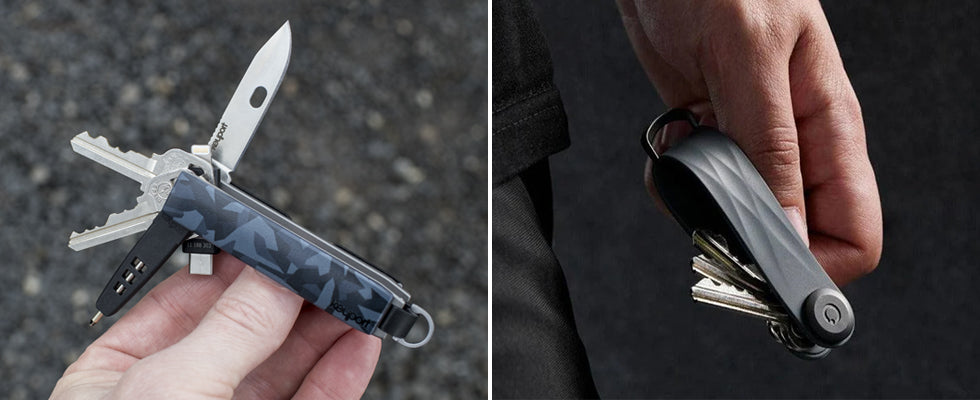
Examples - Keyport Pivot, Orbitkey, Ridge, Jibbon
Mechanism - Keys pivot around a single post or spine, similar to a Swiss Army knife. Some use soft-sided materials like leather or TPU, while others use rigid metals like aluminum, stainless, or titanium for durability.
Advantages
- Easy setup - Spacers not generally required
- Straight-forward access - Push out your keys and tools with one finger from below, select the one you want, and fold the rest back in
- Clear front & back - In modular setups like the Keyport Pivot, this is helpful as modules like the Pocket Flare 2.0 mini-flashlight are pointed in the direction of the key you are using
- Keys are fully covered - Good security, keys don't easily get caught on loose items in pocket, and prevents in-pocket items from getting scratched by keys
Considerations
- Capacity limit - This type of key organizer typically holds between 2 and 8 keys. Any more than 10, and it starts to get a little thick.
- Wear & tear - Soft-sided builds look stylish but tend to show wear sooner than metal versions.
Double-Sided (Sandwich Style)
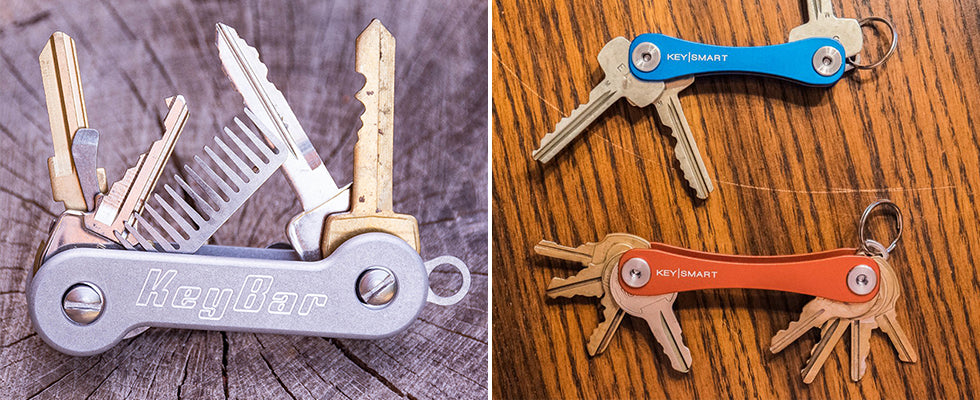
Examples - KeyBar, KeySmart
Mechanism - Keys are organized in a double-sided array, sandwiched between two plates, and secured with screws or bolts. This double-sided style allows keys to fan out from both sides, allowing for a slim profile.
Advantages
- Slim Profile - Keys positioned on both ends make the design look compact, even when it carries more
- Increased Capacity - Can hold more keys compared to single-sided models
Considerations
- Setup is challenging - By far and away, this is the toughest setup of any key organizer. That is because with keys at both ends, you need to set them up interlaced so that they stow correctly. This means a lot of trial and error along with the use of spacers. Otherwise keys stick out a bit.
- Keys stick out - Keys don't always fold in flush, which means they can catch on pocket fabric or scratch other gear.
- Tool compatibility - Limited length means certain pocket tools, like the MOCA 10-in-1 Multi-Tool or Orbitkey Locator, don't fit.
- Keys have a tendency to become loose - Screws may need periodic tightening to keep the assembly secure
Out-the-Front (OTF)
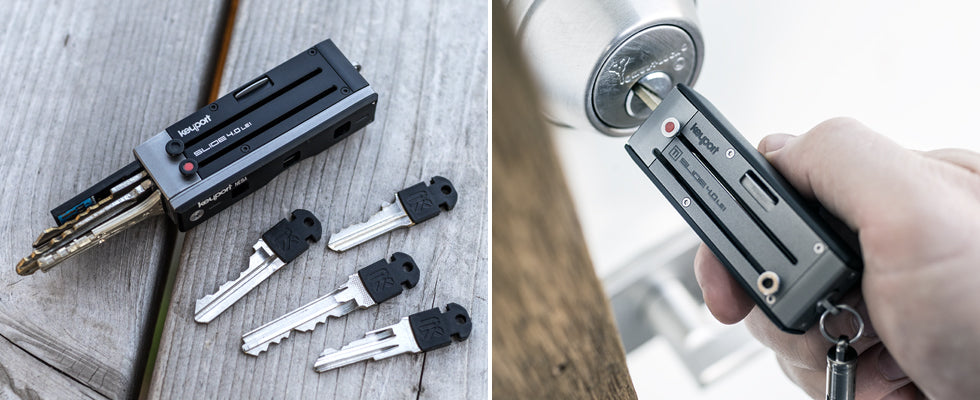
Example - Keyport Slide
Mechanism - Utilizes a chassis with slots that keys slide into and out of and that is activated by a thumb push. This patented out-the-front (OTF) design is unique in that it doesn’t require unfolding but rather a direct slide action which provides truly one-handed access.
Advantages
- Quick no-look access - Allows for rapid deployment of keys with a simple slide action. Memorizing key position is easy for no-look access.
- Time saving - Accessing locks, ignitions, etc., is much faster than other types of key organizers and standard keychains
- Keys are fully covered - Keeps Keyport Key Blades protected and reduces the risk of photo duplication, which is not a common security concern. Cutting duplicate keys by photo is mainstream as companies like KeyMe have demonstrated, so it is best to keep keys covered when possible.
- No unnecessary wear: Keys and tools don't rub against each other reducing wear
- Compact and streamlined: Offers a sleek, high-tech profile with no protruding parts
- Very easy to switch out keys and modules - Faster than a traditional keychain
Considerations
- Limited capacity: Typically holds fewer keys than Swiss Army or sandwich styles at max capacity
- Requires proprietary keys- To fit the Slide, standard keys need to be duplicated onto Keyport Blades. Blades include a one-size-fits-all universal head and are smaller and lighter than traditional keys, but they require an extra step compared to using your existing keys in other organizers.
- International keys require additional effort - Because Keyport doesn't maintain an inventory of all international key blanks, international customers will typically have to send a copy of their keys to Keyport's HQ. Keyport will then custom convert them to Keyport Blades that fit securely in the Slide.
Key Case
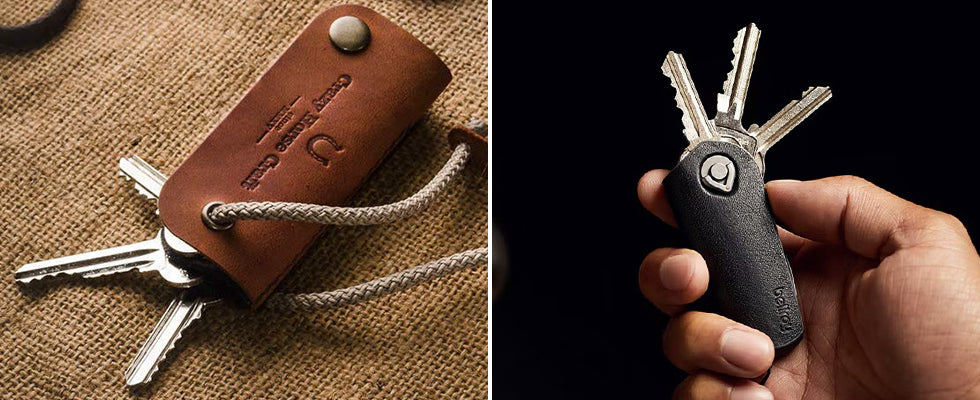
Example - Bellroy, Caran d'Ache, Montblanc
Mechanism - A leather or fabric pouch encases the keys, which are either attached to a central clip or pin & screw inside. The key case design is more traditional and focuses on a wallet-like aesthetic.
Advantages
- Protective - Shields pockets and bags from being poked or torn by keys.
- Wallet-like - Leather and fabric cases often come in a wide range of colors and finishes, giving users more avenues for personal expression.
Considerations
- Bulk - Can be bulkier than other organizers, depending on the number of keys and material
- Capacity - Only holds 2 - 4 standard keys
- Access Speed - Retrieving a specific key can be slower compared to more direct-access designs
Magnetic Key Holders

Examples - Distil Union KeyLoop, Magnetikeys
Mechanism - Magnetic key holders like Magnetikeys use the power of magnets to secure keys in place. In the case of the KeyLoop, keys are placed in magnetic sleeves or covers that attach to a central band or loop. For Magnetikeys, the magnets are installed in the keys for rotation, and the system utilizes a pin to keep them all together.
Advantages
- Ease of Use - Fairly easy to add or remove individual keys
- Slim Profile - The magnetic system allows keys to lie flat against each other, creating a slim and streamlined profile that minimizes bulk and maximizes pocket space.
- Silent Operation - By holding keys tightly together, magnetic key holders effectively eliminate the jingle associated with traditional keyrings, ensuring a noiseless carry.
- Fidget Factor - Magnetikeys rotation provides an enjoyable fidget experience
Considerations
- Limited Key Compatibility - Adding magnets to keys means there are only a limited number of key types this system works for. Not all keys are conducive to having magnetic inserts or cases, which may restrict the range of keys that can be organized using this method.
- Magnetic Interference - Care must be taken to prevent potential interference with electronic devices or magnetic strips on cards due to the strong magnets used in these key holders.
- Weight Limit - The capacity of magnetic key holders is often limited by the strength of the magnets. Overloading the holder with too many keys or accessories may compromise its holding power.
- Cost - Magnetic designs tend to cost more due to the specialized materials and parts.
Clip and Carabiner Key Organizers

Examples - James Brand, KeyUnity
Mechanism - Clip and carabiner key organizers utilize a metal clip or a carabiner mechanism to secure keys and other items. This method allows for the quick and easy attachment of keys to belt loops, bags, or other convenient points, ensuring that keys stay easily accessible throughout the day. The keys may be organized on a single loop or through a series of smaller rings or clips, which offers organization while still maintaining quick access.
Advantages
- Quick Access and Secure Attachment - The ease of access and the ability to quickly attach or detach the organizer from clothing or bags makes it useful for individuals who frequently need to access their keys.
- Versatility - These organizers are not limited to keys alone; they can also hold other EDC items like USB drives or small tools, adding to their utility.
- Durability - Constructed from materials such as stainless steel or aluminum, these key organizers are designed to endure daily wear and tear, making them suitable for both urban and outdoor use.
Considerations
- Bulk - Depending on the number of keys and tools attached, these organizers can add bulk, which might not be ideal for those seeking a minimalist approach to their EDC.
- Potential for Noise - Despite their organizational benefits, clip and carabiner key organizers may not completely eliminate the jingle of keys and tools, especially when carrying multiple items. The keys and tools can still move freely, leading to noise as they jostle against each other.
- Ease of Use vs. Security - Clips and carabiners are handy but can snag and unclip if not secured carefully. Additionally, accessing specific keys or tools might require extra steps compared to other types of organizers.
- Aesthetic and Practicality - The functional design focuses on practicality, which may not align with the preferences of those looking for a sleeker, more minimalist aesthetic in their everyday carry.
These six types of key organizers cover most needs, whether you prioritize capacity, speed of access, or aesthetic appeal. By understanding the mechanisms, advantages, and considerations of each, you can choose the key organizer that best fits your lifestyle and EDC philosophy.
Before choosing a particular key organizer, consider:
- your daily key usage
- how many keys you actually use (not carry out of habit) on a daily basis
- lifestyle needs (e.g. outdoor vs. urban, specific tools or tech)
- aesthetic preferences (metal vs. leather, ability to personalize, etc.)
To maintain focus on the primary types of key organizers, we are going to focus on four of them: single-sided Swiss Army style, double-sided sandwich style, out-the-front (OTF), and key cases.
What materials are key organizers made of?
Key organizers come in a range of materials, each with tradeoffs in style, comfort, and durability. The material of a key organizer affects how it looks, how it feels in your pocket, and how long it lasts. Some brands focus on style and comfort, while others emphasize strength and durability. Here are the categories:
Soft-Sided Materials (Leather, TPU, Canvas)
Lightweight and stylish: Often chosen for their professional or fashion appeal.
Pocket comfort: Soft sides sit comfortably next to your phone or wallet.
Durability tradeoff: Leather stretches, TPU scuffs, and these materials don’t handle water or heavy use as well as metals.

On the softer side of the spectrum, materials like leather, thermoplastic polyurethane (TPU), and canvas offer a classic and sometimes more elegant look that can complement personal style or professional environments. These materials are generally lighter, making them less noticeable in your pocket or bag. They aren’t as water-resistant as metals and tend to wear faster. Most also lack modularity, meaning you can’t attach add-on tools or tech modules like you can with the Keyport Pivot or Slide.
Aluminum
Lightweight and tough: Balances strength and portability, though prone to scratches.
Everyday choice: Widely used in organizers like the Keyport Pivot, KeyBar, and KeySmart.
Aluminum balances strength and portability, which is why it’s so common in organizers like the Pivot, KeyBar, and KeySmart.
Stainless Steel
Heavy-duty: Stronger and more resistant to bending or damage.
Weight tradeoff: Adds bulk in the pocket, but lasts through years of hard use.
Stainless steel is heavier but extremely durable, able to withstand years of hard use without bending or breaking.
Titanium
Premium option: Extremely strong, corrosion-resistant, and long-lasting.
Higher cost: Only slightly heavier than aluminum but much more expensive.
Seen as the top-tier choice: A true investment piece for long-term EDC.
Titanium is only slightly heavier than aluminum (0.8 oz vs 0.7 oz in the Pivot 2.0) but much stronger, corrosion-resistant, and built to last. It’s the top-tier choice and priced like it.
Carbon Fiber and Other Composites
Rigid and lightweight: Offers excellent stiffness-to-weight ratio.
Distinctive look: Matte weave aesthetic appeals to design-conscious buyers.
Tradeoffs: Can be brittle under stress and usually lacks the modularity of metals.

Keyport Pivot in Aluminum (left), Stainless (middle), and Titanium (right)
The tradeoff with metals is added weight compared to leather or fabric, and often higher cost, especially titanium. But for durability and sleek looks, most EDC fans consider it worth it. Despite this, their resilience and sleek appearance make them favored choices for key organizers among many EDC enthusiasts.
Buyer Tip: For durability, go with aluminum, stainless, or titanium. For comfort, leather or TPU work but wear faster. For a unique look, carbon fiber offers low weight and a distinctive weave but is less forgiving under stress.
Are key organizers waterproof or water-resistant?
When considering the durability and practicality of key organizers, one common question is their ability to withstand water. Indeed, waterproof or at least water-resistant key organizers are not just a niche requirement; they're essential for individuals who engage in outdoor activities, live in rainy climates, or simply want the peace of mind knowing their keys and associated tools won't suffer water damage.
Water Resistance in Key Organizers
Many key organizers are designed with water resistance in mind, crafted from materials that inherently resist corrosion and water damage, such as stainless steel, aluminum, and titanium. These materials ensure the organizer itself can withstand exposure to moisture without deteriorating. Some models also add O-rings or gaskets to block water ingress, protecting keys and internal mechanisms from moisture.
Tech Integration and Water Resistance
As key organizers evolve, incorporating technology and tools has become more common, raising questions about their water resistance. For instance, the Keyport Pocket Flare 2.0 mini-flashlight module, carries an IPX4 water/dust resistance rating. It's designed to withstand splashing water from any direction, making it invaluable for use in various conditions without worry about moisture damage.
It's important to note, however, that while many key organizers and their tech components boast water-resistant capabilities, not all are created equal. The level of protection varies, often reflected in the product's price. For tech-integrated models, verifying the presence of an IPX rating is crucial to ensure it aligns with your specific needs and lifestyle.
Maintaining Your Key Organizer Post-Exposure
When it comes to the beach, sand and surf are an especially challenging combination. Sand can get into mechanisms and make your keys and tools harder to move. Giving them a good rinse after the beach and then towel drying them off will go a long way to keeping your key organizer operating smoothly.
Most key organizers aren't fully waterproof, but many are water-resistant enough for daily use and outdoor carry. Always check for IPX ratings if you need true protection.
Buyer Tip: For durability, go with aluminum, stainless, or titanium. For comfort and style, leather or TPU work but wear faster. For a unique look, carbon fiber offers low weight and a distinctive weave but is less forgiving under stress. For outdoor or wet use, look for metal builds or modules with an IPX rating.
What are the dimensions and weight of a key organizer?
The dimensions and weight of a key organizer play a crucial role in its functionality and how it fits into your daily life. These organizers are designed with the dual goal of minimizing bulk while still fitting comfortably into your pocket or bag.
Dimensions
- Length: The length of key organizers typically falls between 2.5 to 4 inches (6.4 to 10.2 cm), a size that accommodates most standard-sized keys while still fitting comfortably in your pocket. It is important to remember that the style of key organizer makes a big difference here. While the KeySmart is a doubled-sided build, it is not able to hold longer high security keys like the Keyport Pivot, which is single sided.
- Width: Width varies more significantly based on the design - single-sided versus double-sided - and the capacity. Width ranges from about 0.5 to 1.0 inch (1.3 to 2.5 cm) depending on design and capacity.
- Thickness: Directly related to capacity, thickness starts as around 0.2 inches (0.5 cm) for a minimalist approach and can reach 0.6 inches (1.5 cm) or more when filled to maximum capacity with keys and tools.
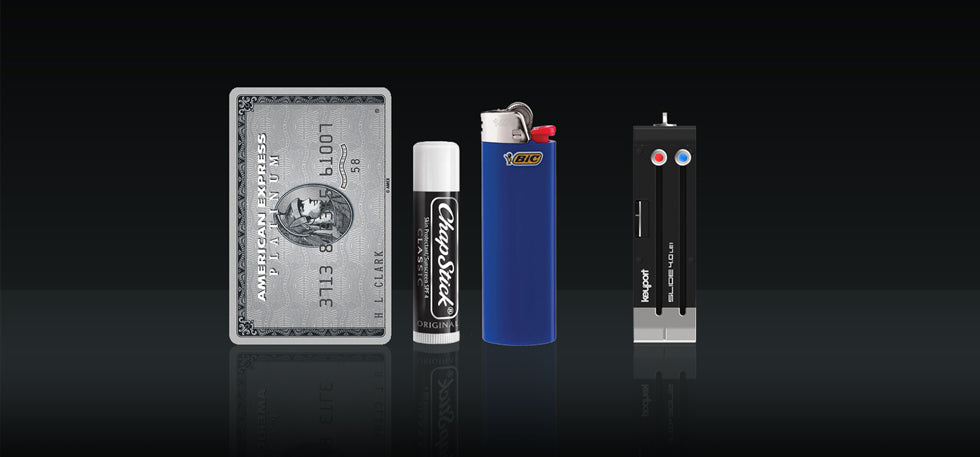
Size comparison of Keyport Slide 4.0 LE1 vs. common objects
Weight
When it comes to weight, key organizers present a spectrum of options:
- Lightweight Designs: Aluminum titanium, or high-grade plastics can weigh as little as 0.5 ounces (14 grams), making them barely noticeable in your pocket. With standard key organizers, the weight ranges from 1 to 3 ounces (28 to 85 grams) when empty.
- Robust Models: For organizers crafted from stainless steel like well-known KeyBar models, they feel heavier, and some EDC enthusiasts actually prefer a heavier key organizer. The stainless steel Keyport Pivot strikes a good balance between the substantial feel of stainless steel and the minimalist aesthetic.
Adding keys and tools increases the overall weight, with a fully outfitted organizer potentially weighing between 2 ounces (57 grams) to over 4 ounces (113 grams). This variability highlights the importance of considering both the base weight of the organizer and the cumulative weight of everything you intend to carry.
A noteworthy innovation in addressing the challenge of bulk and weight in key organizers is found in the design of the Keyport Slide. This organizer utilizes proprietary keys, known as Blades, which significantly reduce the size and weight of traditional keys. By removing a large portion of the metal key head and replacing it with a universal head, the Blades cut down the overall weight by more than half. This design choice ensures that even when the Slide is fully equipped with keys, tools, and modules, it maintains a lower profile and lighter weight compared to traditional setups. This feature exemplifies how specific design innovations can enhance the everyday carry experience by making it more comfortable and convenient, showcasing a unique solution available in the key organizer market.

How many keys can a key organizer hold, and how do key organizers handle different-sized keys?
Capacity
Key organizers vary widely in how many keys they can carry, from minimalist setups with two keys to heavy-duty builds that carry twenty or more. The style and design make a big difference in capacity.
Single-Sided Organizers
Typical capacity: 2 - 8 keys and tools depending on thickness. Some, like Ridge, max out at about 4 - 6.
Best for: Minimalists and people who carry only a few essentials.
Limitations: Car fobs usually need to attach externally on a D-ring or lanyard.
Double-Sided (Sandwich Style) Organizers
Typical capacity: 10–20+ keys when extended with spacers.
Best for: Heavy key carriers who prioritize storage.
Limitations: A significant challenge to set up having to use and coordinate spacers to interlace the keys. Keys often stick up in pocket and catch on loose threads. Bulkier in the pocket, and fobs still need to connect externally.
Out-the-Front Organizers (Keyport Slide)
Typical capacity: 4 Blades and/or tools in the chassis, plus external modules and add-ons.
Best for: Users who want quick access and modular expandability.
Limitations: Requires Key Blades or adapters, but fobs integrate easily with accessories.
Key Cases
Typical capacity: 2 - 5 keys.
Best for: Buyers who value style and simplicity over capacity.
Limitations: Car fobs almost always sit outside on a ring.
Car Fob Reality Check: Most key organizers don’t integrate car fobs inside the chassis. They’re too large and too irregular to fit inside most key organizers, so they almost always ride outside on a D-ring, spinner, or lanyard. Keyport makes this easier with dedicated attachments that keep your fob streamlined with the rest of your setup.
The capacity and versatility of a key organizer are among the first considerations for anyone looking to streamline their everyday carry. Understanding how many keys a key organizer can hold, along with its ability to accommodate various key sizes and shapes, is essential in choosing the right one for your needs.
Handling Different-Sized Keys
When it comes to accommodating different-sized keys, there are a few considerations to keep in mind:
Standard Flat Metal Keys - Virtually all key organizers are designed to handle standard flat metal keys efficiently, maximizing the space available and keeping everything neatly organized.
Larger Motorcycle and High Security Keys - Single-sided and key cases can usually handle these longer keys, but double-sided often have a challenge with them or they have to stick out quite a bit. The Keyport Slide distinguishes itself in handling these types of keys by removing a large portion of the key head so that the corresponding key Blade fits securely in the Slide.
- Auto Keys and Fobs - Pretty much all key organizers handle these similarly in that they hang from a D-ring or lanyard due to their plastic heads and the thickness of the fob. Most of the D-rings allow the auto keys and fobs to fit snugly parallel to the key organizer in a pocket. One standout lanyard to keep an eye out for is the Keyport Slide's spinner as shown below.
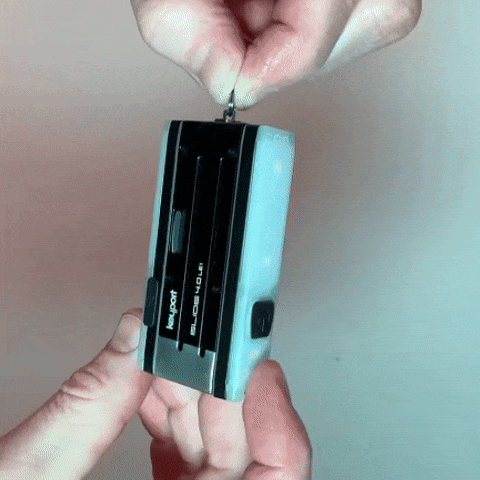
Keyport Slide 4.0 with Fidget Spinner Upgrade
In practice, users with a mix of small, large, or unusually shaped keys will find that most key organizers can accommodate their needs with a little planning. For keys that are too large or oddly shaped to fit within the main body of the organizer, external attachments provide a practical workaround, ensuring that you can carry all your essential items in one compact, organized package. This adaptability ensures that regardless of your key collection's size or shape, there's a key organizer that can streamline your daily carry.
Are key organizers compatible with car keys or auto fobs?
Key organizers offer a streamlined solution to the jumbled mess of traditional keychains, but when it comes to incorporating car keys or electronic fobs is tricky. The bulk makes them impractical to house inside most key organizers without compromising size and comfort.
Here's what to keep in mind regarding car keys and key organizers:
- Swiss Style Key Organizers - Some all-metal auto keys, especially those without transponder chips, might fit into Swiss Style key organizers. Motorcycle and car keys are typically longer keys, so some double-sided (sandwich) style key organizers may not be able to fit the longer keys. Even if they can fit, however, caution is advised to avoid accidental shut-off while driving. It's recommended to use these organizers for auto and moto keys only when there's no risk of accidental shutoff.
- The Slide - Keyport Slide offers a unique solution by removing the head of the auto key and converting them to Keyport Blades, making some car keys compatible. The fob can then be attached to the D-ring, offering a compromise between functionality and compactness.
- Key Cases - While a key case might enclose a fob, it would need to be considerably large to fit both the fob and other keys, potentially defeating the purpose of reducing bulk.
Attaching Auto Keys and Fobs via Lanyard
For larger car keys and fobs, many key organizers provide the option to attach these items via a lanyard. This method maintains the organizer's integrity while still keeping all keys together. In addition to our D-ring, we offer a range of premium magnetic quick-releases with Neodymium magnets so that you can easily detach and reattach instantly when needed.

Keyport Pivot 2.0 Titanium with magnetic quick release holding car key
As with any setup, avoid carrying too much eight on the ignition as some vehicles are especially sensitive to heavy keychains.
Enhancing Compatibility and Convenience
- Custom Adapters: Some brands offer custom adapters that allow for the integration of larger or oddly shaped car keys and fobs into their systems, ensuring a wider range of vehicle keys can be accommodated without compromising the organizer's design.
Proximity Keys and Minimalist Approach: Modern vehicles often use proximity keys that don't need to be removed from your pocket to unlock or start the car. Reflecting on the trend towards proximity keys, which require no physical insertion into the vehicle to operate, key organizers can be even more streamlined. For these users, carrying a bulky fob becomes unnecessary, as the key can remain pocketed, making the key organizer solely for additional keys and tools.
-
Innovative Solutions for Modern Challenges: As vehicles evolve, so do key organizers. Brands are continually developing new modules and attachments to address the growing variety of car key and fob designs, giving users more ways to manage car fobs without losing the benefits of a compact organizer.
Ultimately, most organizers won’t house bulky fobs inside, but accessories like D-rings, spinners, and quick-releases make them easy to carry. With proximity keys becoming the norm, fobs are less of a daily obstacle than they used to be. These allow users to maintain the convenience of a key organizer without sacrificing the functionality needed for modern vehicle operation.
Brands are continually developing new modules and attachments to address the growing variety of car key and fob designs, ensuring users have access to the latest in both vehicle and key organizer technology. By staying informed about the latest options and accessories available, users can enjoy a comprehensive, organized, and efficient way to manage all their keys, including those for their vehicles without compromising on functionality or risking vehicle operation.
Buyer Tip: Don’t force your car fob into a chassis. Use a D-ring, lanyard, or spinner to keep it streamlined, and check your vehicle manual. Some ignitions are sensitive to heavy keychains.
How does a key organizer minimize or eliminate key jingle compared to traditional keychains?
Key organizers eliminate key jingle by holding keys tightly in place so they don't swing and clash like on a traditional keyring. Key organizers employ several smart design features to achieve this:
Tight Stacking: Keys are stacked closely together in a compact layout, often sandwiched between two plates or bars. This tight arrangement leaves little room for keys to move or swing, thus reducing noise.
Pivot or Slide Mechanism: Depending on the style of the organizer, keys either pivot out for use or slide out from a central housing. This controlled movement ensures keys only move when intentionally being used, staying quiet otherwise.
Adjustable Tension: Many key organizers feature screws or bolts that can be tightened to adjust the tension holding the keys together. By increasing this tension, keys are held more firmly in place, further reducing any potential movement and noise.
Material Cushioning: Washers, spacers, or bands separate keys and dampen sound.
Enclosed Designs: Certain key organizer models encase the keys entirely, either in a leather pouch or a hard shell casing. This design not only prevents the keys from moving but also physically blocks any noise from escaping.

A good key organizer keeps your keys silent
By addressing the root cause of key jingle through strategic design and material choices, key organizers offer a quieter and more comfortable alternative to carrying keys, making them ideal for individuals who want to reduce noise in their everyday carry. Thanks to these thoughtful design elements, key organizers not only silence the jingle but do so with style. It's about being less like Jerry the Janitor, with a jangling keychain, and more like James Bond - sleek, sophisticated, and stealthy.
Buyer Tip: If noise drives you crazy, look for organizers with adjustable tension or enclosed designs. They’re the most effective at keeping your carry silent.
Can key organizers integrate tools or smart technology?
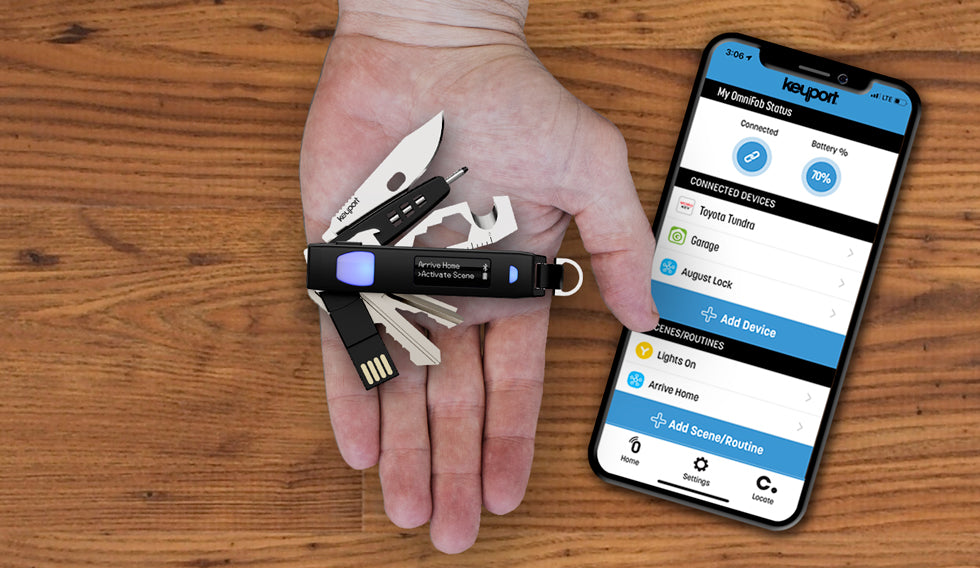
Keyport Pivot with OmniFob smart remote, flash drive, and other tools
Key organizers have indeed become sophisticated platforms that not only streamline your key carrying experience but also enhance it with a variety of tools and smart technology integrations. These modern organizers can carry everything from the basic tools like bottle openers and USB flash drives to more advanced tech like Bluetooth locators and NFC-enabled devices.
Multi-Tools and Accessories - Many key organizers now offer the ability to include various pocket tools such as bottle openers, multi-tools, pens, USBs, and knives, adding layers of utility to the already functional design.
Bluetooth Locators - For those prone to misplacing their keys, some key organizers incorporate Bluetooth technology for easy location. The Keysmart Max includes a built-in locator, while Orbitkey sells a separate insert.
Keyport’s Modular System - Keyport takes customization and tech integration to another level with its modular system, offering:
- Pocket Flare 2.0 Module - 3-mode mini-flashlight focused in the direction of your extended key
- Popl x Keyport Digital ME Key - An NFC-enabled digital business card that facilitates contact sharing with a tap.
- RFID Key - Developed in partnership with CloneMyKey, allowing for seamless access control integration.
- Barcode Faceplates - Ideal for gym memberships or loyalty tags, simplifying wallet clutter.
- Ledger Nano Hard Wallet Adapter - For those invested in cryptocurrencies, providing a secure way to carry a hardware wallet.
- OmniFob Universal Smart Remote - Offers control over various smart devices and includes a Chipolo-compatible Bluetooth locator for added functionality and security.
Enhancing the Key Organizer Experience
The integration of tools and smart technology in key organizers significantly elevates their utility and functionality, making daily tasks simpler and more efficient.
Opting for a key organizer with modular technology and tool integrations also future-proofs your investment. This adaptability ensures that as technologies evolve or personal needs change, the key organizer remains relevant and useful without the need for complete replacement.
Furthermore, many of these technological integrations, such as RFID keys and Bluetooth locators, enhance personal safety and security. They not only make daily activities more efficient but also add a layer of protection against loss and theft.
Lastly, the extensive customization options available with key organizers like Keyport allow users to tailor their devices to fit their specific needs and lifestyle. Whether prioritizing aesthetics, functionality, or both, the ability to personalize a key organizer ensures that it perfectly complements the user's daily routine.
Through these innovations, key organizers have transformed into indispensable tools for the modern individual, providing not just organization but also enhancing everyday life with practical, secure, and tech-savvy solutions.
Do key organizers come with additional tools or features?
Key organizers are not just about tidying up your keys; many include tools or accessories that go beyond key storage. The extent of these add-ons varies by brand and model, so a bit of homework is required to find the perfect match for your needs.
Some key organizers integrate additional features directly into their design. For instance, Keysmart includes a locator within some models, but when tech changes, the entire organizer may need replacing. Keyport’s modular design avoids this problems. It allows for easy updates and customization without the need for a completely new organizer.
Keyport takes the concept of additional features a step further:
- KeyportID Lost & Found - Every Keyport key organizer includes a free two-year subscription to KeyportID, an exclusive service that uses a unique serial number inscribed on each Keyport to let finders easily and securely contact you. This service operates independently of WiFi or Bluetooth, ensuring it's always available.
- Modular System - Keyport’s modular approach allows for the integration of various tools and modules. This means your key organizer can evolve with your needs or as new technologies emerge, without requiring a complete replacement.
- Bundles - Keyport offers kits like the Pivot 2.0 Essential Plus Bundle, which includes a Pivot 2.0 key organizer, MOCA 10-in-1 Multi-Tool Insert, Pocket Flare 2.0 mini-flashlight Module, and the RuSH Tool for effortless setup and module changes. These bundles offer a comprehensive solution for your everyday carry needs right out of the box.
By offering a range of product bundles and modular options, Keyport not only provides immediate utility but also ensures your key organizer can adapt and grow with you over time, making it a versatile and valuable component of your daily routine.
Expanding on Key Organizer Customization and Utility
- Universal Compatibility - A critical factor in selecting the right key organizer is its ability to accommodate a variety of key types and tools from different brands. This versatility ensures that your key organizer can meet a broad spectrum of needs and preferences, making it a truly universal tool in your everyday carry.
Security Features Beyond the Basics - In an era where security is paramount, some key organizers offer enhanced features like RFID blocking capabilities or tamper-resistant builds. These additions protect not just your keys but also your personal information, adding an extra layer of security to your daily carry.
Advanced Tech Integration - Beyond locators, modern key organizers may incorporate LED lights for visibility in low light conditions, or even digital tools that work in tandem with physical ones, transforming your key organizer into a compact tech hub.
Community Support - Opting for a brand with a strong community presence, accessible tutorials, and proactive customer service make it easier to get the most out of your key organizer.
By focusing on these aspects when choosing a key organizer, you ensure that your selection not only efficiently organizes your keys but also integrates seamlessly into your life through customization, security, and technological advancements. Whether you opt for the adaptability of Keyport’s system or the distinctive features of other brands, the ideal key organizer will become an indispensable part of your daily routine.
Can key organizers be customized or personalized?
Key organizers have evolved beyond simple key-holding devices into versatile tools that can be extensively customized and personalized to fit individual preferences and needs. While the basic function of a key organizer is to keep keys neatly organized and compact, the customization options available today significantly enhance both utility and style.
Many leading key organizer brands offer an array of customization choices, including:
- Materials and Colors - From durable metals to vibrant plastics, allowing users to choose a key organizer that fits their style.
- Pocket Tools and Accessories - Options like bottle openers, USB drives, and multitools can be added, turning a simple key holder into a multifunctional gadget.
- Custom Engraving- For those looking for a personal touch or corporate branding, some brands offer custom engraving (usually for bulk orders). Engraving isn’t possible on leather or fabric models, though stitching options sometimes exist.
Buyer Tip: If you want tech that won’t go obsolete, avoid organizers with built-in electronics. Modular systems like Keyport let you add, remove, or upgrade tools and smart features without replacing the whole organizer.
Keyport: The Pioneer of the Modern Key Organizer
When the first Keyport Slide launched in 2007, it introduced a new way to carry keys that was compact, pocket-safe, and customizable. That design helped establish the modern key organizer category and inspired the wave of alternatives that followed. Over the years, Keyport’s Pivot and Slide have appeared in numerous best key organizer roundups and gear reviews for their combination of engineering precision and everyday practicality.
Even without any add-on modules, the Keyport Pivot key organizer is recognized for its durable construction, no-spacer setup, and proprietary locking system that prevents loosening, plus the built-in KeyportID™ lost-and-found service. The Keyport Slide remains the only key organizer offering true one-handed access in a still-unique and streamlined form factor.
For many reviewers, that balance of craftsmanship, convenience, and longevity explains why Keyport continues to be cited among the best key organizers, even before considering its modular capabilities.
Keyport: A Model of Key Organizer Customization
Having established the Pivot and Slide as top-tier key organizers in their own right, Keyport’s modular platform demonstrates how thoughtful design can extend functionality without complexity. Like other leading key organizers, Keyport provides a diverse selection of materials, colors, and pocket tools, but it take customization and personalization to the next level:
- Unique Organizers - The Pivot and the Slide offer two distinct formats - Swiss Army-style Pivot or out-the-front Slide - so users can pick the setup that best fits their carry style.
- Substantive Modules - Beyond standard tools, Keyport offers modules like the Pocket Flare 2.0 Mini-Flashlight, NEBA Knife, and OmniFob universal smart remote that snap into the chassis, enhancing functionality without adding bulk.
- KeyportID Lost & Found - Keyport provides a free 2-year KeyportID subscription that offers a safety net no other key organizer includes.
- Custom Printed Faceplates - For ultimate personalization, Keyport offers custom printed Faceplates, similar to knife scales, letting users personalize their organizer easier than swapping a phone case.
These features collectively position Keyport not just as a key organizer but as a comprehensive, highly versatile everyday carry system.

With such depth in customization and personalization options, users can tailor their key organizers to reflect their personality, meet their functional needs, or even serve as a platform for expressing their individuality. With such a wide range of options, Keyport turns the key organizer into a full everyday carry system - adaptable, modular, and personal.
Are key organizers worth it?
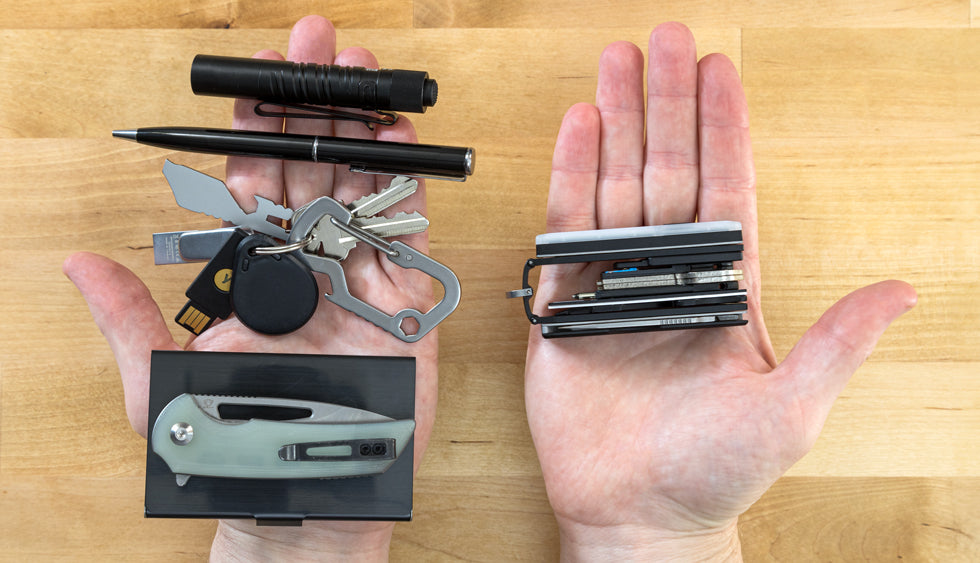
EDC Before and After the Keyport Pivot modular key organizer upgrade
Key organizers can be a smart upgrade to your everyday carry for several reasons:
- Enhanced Organization - Say goodbye to the frustrating key shuffle. Key organizers bring order to your key collection, making it faster to grab the right key when you need it without fumbling.
- Protection - No more scratches on your phone screen or leather wallet. Key organizers keep sharp edges neatly tucked away, keeping your phone, wallet, and pocket gear scratch-free.
- Noise Reduction - Enjoy a quieter arrival whether you’re coming home late or starting the car early in the morning. Key organizers significantly cut down on the jingle of traditional keychains.
- Comfort and Aesthetics - Slim designs mean no pocket bulge and look more refined than a bulky, jangling keychain. The sleek, modern design of key organizers enhances both the comfort of carry and your style quotient.
- Built to Last - Crafted from materials like aircraft-grade aluminum and stainless steel, key organizers are designed for durability, offering prolonged use and reliability over conventional keyrings.
- Customization - Tailor your carry with additional tools and features. Whether it’s a bottle opener for the weekend BBQ or a USB drive for work, key organizers adapt to your lifestyle.
While a key organizer costs more than a basic keyring, the convenience, protection, and customization usually outweigh the difference. For most EDC users, it’s a long-term upgrade worth making. For those weighing the pros and cons, check out Are Key Organizers Worth It? for a detailed analysis of their value proposition.
Buyer Tip: If you use your keys every day, investing in a key organizer makes as much sense as carrying a decent wallet or phone case - it’s not just nicer, it’s practical.
How do I choose the right key organizer for me?

Choosing the right key organizer is a personal decision, reflecting your specific needs, lifestyle, and values. At Keyport, we believe the ideal key organizing system should embody a blend of utility, convenience, technology, security, and style. These principles, while central to Keyport's design philosophy, are universal benchmarks that can guide you in assessing any key organizer. Here’s how to ensure you make the best choice for your everyday carry:
- Assess Your Needs and Values - Determine what's crucial for you in a key organizer. Is it the capacity for multiple keys and tools, a slim and minimalist design, or perhaps advanced features like smart technology integration? Your preferences should steer your search for the perfect key organizer.
- Durability and Material Choices - Select a key organizer built to last. Whether you prefer the lightweight durability of aluminum key organizers, the sleekness of stainless steel, or the eco-conscious appeal of recycled materials, the construction quality is paramount.
- Lifestyle Compatibility - Choose a key organizer that complements your daily activities. Whether you're an outdoor enthusiast in need of a rugged key holder, a professional seeking a sleek accessory, or a traveler looking for compact and secure storage, there’s a key organizer designed just for your lifestyle.
- Security Features - Opt for a key organizer with robust security features. Look for options that offer locking mechanisms, RFID features, and/or lost & found to keep your keys secure and your information safe, an essential aspect for tech-savvy users and security-conscious individuals alike.
- Ease of Use and Accessibility - Convenience is key. Search for user-friendly key organizers that allow easy access and simple management of your keys, ensuring a hassle-free experience every time you need to add or remove a key.
- In-Depth Research - Go beyond basic comparisons. Explore comprehensive reviews, customer feedback, and expert opinions to understand the performance and reliability of various key organizers, including popular models and emerging brands. Dive into the brand's website to understand their ethos and product range. For Keyport, flexibility and the ability to customize your carry to suit your evolving needs and style stand out.
- Brand Engagement - Reach out and ask questions. Communicate with brands directly to gauge their customer service quality. A responsive and supportive brand can enhance your overall experience with a key organizer, from purchase to daily use. Interacting with the brand or its community can provide insights into the product's real-world utility and the company's customer service ethos. Is this a brand you’d feel proud to have as your everyday wingman?
- Future Flexibility - Anticipate changes in your key-carrying needs. Modular key organizers offer the flexibility to adapt by adding new keys or accessories, making them a versatile choice for those who value adaptability.
When selecting the right key organizer, consider it an extension of your personal and professional life. Whether it aligns with Keyport’s modular system or another brand, the key is to find a key organizer that simplifies and enriches your daily routine, making every day a little easier and a lot more organized.
Buyer Tip: Count the keys you actually use daily, then pick the style that fits that number. Add your car fob on a D-ring or spinner to keep bulk down.
What are the best key organizers in 2025?
When exploring the best key organizers for 2025, it's important to approach the topic with an open mind, given the wide range of options available. Each year, numerous lists and articles tout the "best" key organizers, but it's essential to remember that many of these are affiliate supported, which can affect depth and objectivity. That said, Keyport often features prominently in these discussions, thanks to its long-standing focus on innovation, build quality, and everyday practicality.
While Keyport is often featured among the best key organizers—appearing in dozens of lists and reviews from outlets like Engadget, The Modest Man, and Lifehacker, this guide aims to remain educational and unbiased. Our goal is to help readers understand what defines a truly exceptional key organizer, whether that’s a simple, high-quality solution like the Keyport Pivot or a more advanced setup that integrates tools and technology into a modular EDC platform. The way we see it, as long as the Pivot and Slide continue to appear in conversations about the best key organizers, from minimalist builds to full-featured systems, then we’re doing our job: advancing what a key organizer can be.
In the spirit of providing an unbiased perspective, here are some general guidelines to help you navigate your options:
- Research Thoroughly: Look beyond top-ten lists and delve into user reviews and expert opinions that offer in-depth analysis and hands-on experience. This research can provide a clearer picture of how each key organizer performs in real-life scenarios.
- Consider Your Needs: Reflect on what you value most in a key organizer—whether it's compactness, durability, the ability to customize, or tech integration. Your priorities should guide your choice.
- Evaluate Policies: Before making a decision, examine the warranty and return policies of the products you're considering. A company confident in its product will often offer a robust warranty, which can be a sign of quality and reliability.
- Engage with Brands: Don't hesitate to reach out to companies directly with your questions. A responsive and helpful customer service team can significantly enhance your overall experience with the product.
Additionally, keeping an eye on the latest technological advancements and design innovations in the key organizer market can provide valuable insights into choosing a model that will serve you well into the future. Features such as integrated smart technology, enhanced durability, and eco-friendly materials are increasingly becoming standard expectations for consumers seeking the best in 2025.
It's also wise to engage with the wider EDC community through forums and social media. These platforms offer a wealth of user-generated content, including reviews, comparisons, and personal recommendations, which can shed light on the real-world performance of various key organizers beyond what you might find in affiliate-driven content.
For those interested in Keyport's offerings, we pride ourselves on the most versatile key organizing system on the planet, designed around customer values of utility, convenience, technology, security, and style. From minimalist setups to fully modular configurations, the Pivot and Slide continue to demonstrate why versatility and craftsmanship are at the heart of the best key organizers. We encourage potential customers to contact us with any questions, ensuring you have all the information needed to make an informed decision.
Choosing the right key organizer is about finding the perfect match for your lifestyle and preferences. By taking a thoughtful and informed approach, you can select a key organizer that will serve you well in 2025 and beyond.
Where can I purchase a key organizer and what are the price ranges?
When navigating the purchase of a key organizer, considering both the buying source and the expected investment for quality is crucial. Here's an updated guide that includes thoughtful considerations on price and value:
Where to Purchase
- Company’s Website - Ideal for getting to know the brand, its values, and exploring exclusive deals. Keyport's site, for instance, features specials, limited editions, and pre-order opportunities that you won't find elsewhere.
- Online Marketplaces - Platforms like Amazon, Walmart, and eBay allow for easy comparison across brands and offer a wealth of customer reviews to inform your choice.
- Local Retailers - For those who prefer a hands-on shopping experience, local stores provide the opportunity to physically inspect a key organizer's build and functionality.
Buyer Tip: Treat a key organizer like a wallet purchase. Mid-range metal builds usually deliver the best long-term value, and modular systems extend lifespan by letting you upgrade parts, not the whole organizer.
Price Ranges and Value Insight
Understanding the different price tiers is key to finding a balance between cost and quality:
- Budget-Friendly (Under $25) - Venture here with caution—while you may find a diamond in the rough, remember that many options in this range are like party balloons: fun until they pop (or in this case, loosen or scatter your keys across the parking lot).
- Mid-Range ($25 - $50) - This price range is the goldilocks zone, offering a solid balance of durability, functionality, and aesthetic appeal without needing to break the bank.
- Premium (Above $50) - Tailored for those who demand excellence in every detail, premium key organizers deliver unparalleled materials, craftsmanship, and the luxury of customization. Not every premium product contains all of these elements, so diligent research is essential. While brand name carries its weight, remember that this is a working product, not just a trophy accessory. You want to ensure it not only looks the part but can also perform the job(s) required efficiently.
Additional Considerations for Choosing the Right Key Organizer
In addition to the factors already mentioned, it's wise to factor in the adaptability of the key organizer to future needs. A modular design, for example, offers the flexibility to add or remove keys and tools as your daily requirements change, providing a longer-term value beyond the initial purchase price. Also, consider the ergonomic design and how it fits into your hand and pocket for daily use. An organizer that feels good to the touch and doesn't create bulk can significantly enhance your everyday carry experience.
Moreover, the community and customer service behind the brand can be just as important as the product itself. Brands that foster a strong community and offer exemplary customer service provide added value, ensuring that any questions or concerns you might have post-purchase are addressed promptly. This level of support can significantly enhance your satisfaction and confidence in your key organizer.
The Value of Investing in a Key Organizer
Considering a key organizer's cost in comparison to a traditional keychain is crucial. Remember, it's one of the three essentials you carry and use multiple times daily, alongside your wallet and phone. A quality key organizer not only organizes your keys efficiently but also brings a touch of joy to what could be mundane moments—like opening your front door after a long day or securing your bike at the rack. Given its role in your daily life, investing in a key organizer that offers durability, style, and ease of use is not just practical; it's essential. After all, it's not just about holding keys; it's about unlocking a smoother daily routine.
How do you make a key organizer?
Building your own DIY key organizer can be a fun project. It gives you total control over design and the satisfaction of carrying something you made yourself. But it also comes with tradeoffs: professional organizers benefit from years of design and engineering, so they’re more durable, more reliable, and less likely to loosen or frustrate you over time.
The DIY Route
Most accessible styles: Swiss Army style (single-side) or sandwich builds.
Common challenges: Standard pins and screws often loosen with daily use.
Learning curve: Getting the spacing right can feel like trial and error.
-
Resources:
- Instructables - DIY KeySmart/Key Organizer: Offers a step-by-step guide to creating a compact key organizer similar to the popular KeySmart design. View Tutorial
- Instructables - How to Make a Key Organizer: Another guide that walks through the process of making a basic key organizer, providing insights on necessary materials and assembly. View Tutorial
While exploring these DIY options, keep in mind that:
- Using standard pins and screws may lead to loosening with daily use, which means frustrating all-too-frequent retightening.
- Considering the cost and effort, sometimes purchasing a key organizer can be more cost-effective, especially since many are available for under $50. These products benefit from professional design and manufacturing, offering durability and ease of use.
The Professional Route
Professional organizers are the result of years of testing, engineering, and real-world feedback. They’re built to solve the problems DIY builds often struggle with, delivering durability, convenience, and reliability right out of the box.
Ready out of the box: Professionally made organizers are designed to be frustration-free.
Durability advantage: Materials like aluminum, stainless, or titanium outlast DIY builds.
Affordable: Many start under $50, making them cost-effective compared to sourcing DIY parts.
The Middle Ground: Maker Programs
If you want the best of both worlds, Keyport offers a modular platform that’s designed for customization. Through maker programs and an active Discord community, you can build on a solid chassis and add custom modules, inserts, or accessories. That way, you get the fun of personalization with the reliability of professional engineering. This can be an excellent middle ground, providing the foundation of a professionally designed chassis and the flexibility to add custom modules, inserts, and accessories.


Ultimately, whether you decide to DIY or buy, remember to weigh the cost of materials, time, and potential frustration against the convenience and reliability of a professionally made key organizer.
Are key organizers easy to assemble and reconfigure?
Ease of setup and reconfiguration is a major factor in choosing the right key organizer. Nobody wants to turn adding or removing keys into a puzzle-solving session. A good organizer should come with clear instructions, simple parts, and ideally a few how-to videos on the brand’s website. Accessible support, whether by email or phone, should also be available when things don’t go smoothly.
However, not all key organizers are created equal when it comes to the ease of making adjustments. With our extensive testing and design experience, it is clear that Sandwich style organizers can present a more challenging puzzle. The trick lies in aligning keys precisely on both ends to avoid interference, often requiring a dance with spacers to find the perfect fit. It's akin to playing Tetris with your keys, where finding the right configuration can sometimes be frustratingly elusive.
Single-Sided (Swiss Style)
Setup difficulty: Moderate to low if designed well. Usually requires a single screw or post, no balancing act on both ends.
Reconfiguration: Easy to add or remove keys compared to sandwich style.
Bottom line: Slimmer capacity, but a much easier experience.
Key Cases
Setup difficulty: Very low. Slide keys onto a bar or strap, close the case, done.
Reconfiguration: Just as simple. The tradeoff is limited capacity.
Bottom line: Easy setup, style-first function.
Double-Sided (Sandwich Style)
Setup difficulty: High. Keys must align on both ends with spacers or washers in place, often requiring trial-and-error.
Reconfiguration: Adding or removing a key can feel like playing Tetris with metal. Extra parts (tiny screws, posts, spacers) make it fiddly.
Bottom line: Maximum capacity, but the steepest learning curve.

Double-sided key organizers can be difficult to assemble with many tiny parts and washers
While the double-sided (sandwich style) key organizers might pose the most significant challenge due to alignment issues and the necessity for incorporating spacers, single side key organizers, on the other hand, if designed correctly should be relatively easy to set up and reconfigure.
Out-the-Front (Keyport Slide)
Setup difficulty: Requires initial loading of Key Blades or adapters but is straightforward with instructions.
Reconfiguration: Quick. In time tests, removing a key and adding another to a Slide was faster than swapping one on a traditional keyring.
Bottom line: Low-maintenance, one of the simplest systems once keys are loaded.
Here are a few example support videos from Keyport demonstrating setup of the Pivot and the Slide as well as removing modules, a unique attribute of the Keyport's modular everyday carry system. And yes, while configuring these can sometimes feel like trying to solve a Rubik's Cube blindfolded, the right resources and support can turn it into a more "plug-and-play" experience.
Pivot 2.0 Setup Video: Demonstrates the straightforward process of adding new keys and tools to your Pivot 2.0, aiming to simplify your experience.
Slide Setup Video: Offers a step-by-step guide to setting up your Slide, ensuring a hassle-free assembly.
Module Removal Video: Provides clear instructions for removing modules, facilitating easy customization and maintenance of your key organizer.
For setup and reconfiguring purposes, both the Slide and key cases are relatively simple. In fact, in time tests, we were able the remove a key and add another key to a Slide faster that pulling one off of a standard key ring and adding another onto it.
Remember, the goal of a key organizer is to bring convenience and order to your daily carry, not to test your patience. With the right tools and guidance, adding or removing keys and tools from your organizer should be as easy as pie—or at least as simple as making a sandwich, even if it's the double-layered kind.
How do you prevent keys from loosening over time?
Preventing your keys from turning into a floppy, jingly mess over time is a concern shared by many who’ve transitioned from the chaos of a traditional keyring to the sleek efficiency of a key organizer. The secret to maintaining that crisp, satisfying snap of perfectly tensioned keys? Choosing the right key organizer from the get-go. Think of it like picking a car with well-inflated tires instead of one that constantly leaves you on the side of the road pumping air.
When shopping for a key organizer, dive into the product descriptions with the zeal of a detective. Look for clues in the form of screw and pin design specifics.
Standard Screw-Based Organizers
Many key organizers (KeyBar, KeySmart, Ridge) use or have used standard screws and posts. Over time, daily twisting and pocket pressure loosen them, forcing you into a tightening tango now and then. It works, but it can feel like you’re forever playing mechanic with tiny screws.
The Keyport Pivot Solution
The Keyport Pivot avoids this by using a proprietary locking mechanism that’s more secure than a spy’s briefcase. Detents and ball bearings click into place every 90 degrees, letting you dial in the perfect tension so your keys stay as orderly as a row of soldiers. The Pivot 2.0’s anti-rotation system locks the stack tightly, dramatically reducing the need for retightening.
Keyport Slide - No Screws Needed
This design eliminates the problem altogether. Keys sit in individual slots and slide out on demand, so loosening isn’t part of the equation.
Key Cases with Post or Bar
These use a post or bar wrapped in leather, which also sidesteps the constant screw-tightening cycle, though durability depends on the material.
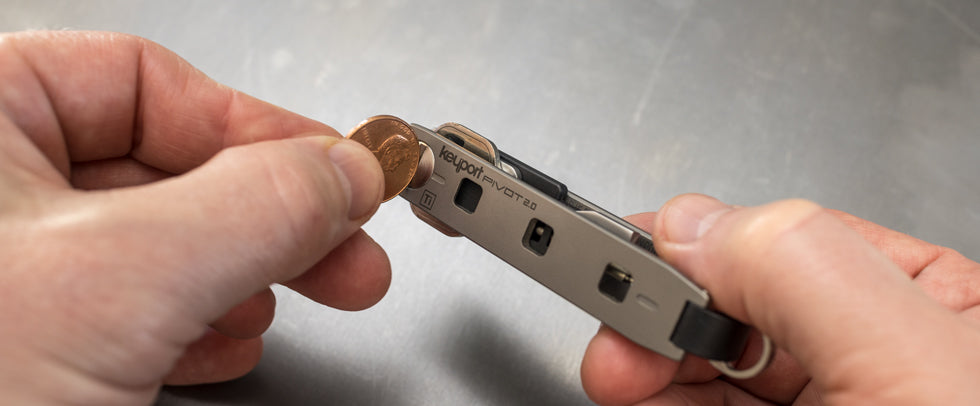
The Keyport Pivot 2.0's anti-rotation mechanism locks your key stack tightly
Of course, even the best key organizers might require a minor tension tune-up over time as keys shift a bit with use. However, this is a far cry from the daily dread of tightening screws that seem to have a life of their own. And for those opting for a Keyport Slide or a key case, this particular plot twist of loosening keys doesn’t even make it into the story, thanks to designs that inherently eliminate such concerns.
In essence, investing in a key organizer with a robust locking mechanism is like choosing a trusty sidekick that won’t let you down - keeping your keys tight, right, and out of sight, without the daily screw-tightening saga.
How Do You Set Up, Maintain, or Clean a Key Organizer?
Maintaining and cleaning your key organizer not only prolongs its life but also keeps it functioning smoothly day after day. The good news: the process is simple, doesn’t require special tools, and works across different types - from Swiss-style to the Keyport Slide to traditional leather key cases.
Cleaning Swiss Style Key Organizers
Swiss-style key organizers, known for their compact, efficient design, are easy to maintain:
- Quick Cleaning - Fan out all the keys and tools and use compressed air to blow out dust, lint, and debris.
- Advanced Cleaning - Rinse the chassis in warm water, disassemble, and place each component on a dry towel. Wipe each piece with a rag, let everything dry completely, and reassemble.
Leather Versions - Leather requires a bit more effort. If your Swiss-style is leather-wrapped (e.g., Orbitkey, Jibbon), follow the leather care steps below instead of rinsing in water.
Buyer Tip: Metal organizers are generally lower-maintenance than leather ones. They resist moisture, shrug off scratches, and rarely need more than a quick dust-out.
Maintaining the Keyport Slide
The Keyport Slide, with its unique mechanism, requires a slightly different approach:
- Quick Cleaning: Blow out each port with compressed air while moving the Blades back and forth.
- Advanced Cleaning: Disassemble Slide and place each component on dry towel. Clean and dry each component individually with a dry towel to remove dust, lint, and debris. Blow out Slide Ports with compressed air and reassemble.
In general, it is fair to say that metal key organizers are significantly less work than leather key holders and cases to maintain. Because the keys are fully enclosed, the Slide tends to collect less lint and grime inside the chassis than open-frame designs.
Leather Key Case Maintenance
Leather key cases look sharp and age gracefully, but they need regular care to last. A well-maintained leather case develops a rich patina instead of cracking or fading. Here's how to keep your leather key case in pristine condition:
- Regular Dusting - Use a soft, dry cloth to gently dust your leather key case. This prevents dirt from accumulating and embedding into the leather's pores.
- Cleaning - For a deeper clean, lightly dampen a cloth with water and a mild soap. Gently wipe the surface of the leather to remove any dirt or stains. Avoid using too much water, as leather doesn't respond well to excessive moisture.
- Drying - After cleaning, let the leather air dry naturally. Do not use heat sources like hair dryers, as this can cause the leather to become brittle and crack.
- Conditioning - Once dry, apply a small amount of leather conditioner with a soft cloth. This step is crucial for keeping the leather supple and preventing cracks. Use circular motions to rub the conditioner into the leather, then let it absorb and dry.
- Storing - When not in use, store your leather key case in a cool, dry place away from direct sunlight or heat sources. This helps prevent the leather from drying out or fading.
Here is a leather wallet cleaning video that is applicable to leather key organizers:
Additional Leather Key Case Tips
- Avoid Overloading - Overstuffing a leather key case can stretch the leather and warp its shape. Keep the contents to a necessary minimum to maintain its form and integrity.
- Immediate Care for Spills - If your leather key case gets wet or is exposed to spills, clean it immediately with a dry cloth and let it air dry naturally. Prompt action can prevent water stains and damage.
Lock Maintenance
Don't forget about the locks your keys belong to. Applying a bit of Lock Lube can keep them turning smoothly without resistance. This preventative measure can save you from future headaches and ensure your locks remain in good working order.
Regular maintenance of your key organizer and the locks it opens is not just about cleanliness; it's an essential practice to ensure longevity and reliability. Taking a few minutes to perform these simple steps can greatly enhance your everyday carry experience.
Final Verdict: The 3rd EDC Essential
We’ve covered the big questions: how key organizers work, the materials that make them last, how many keys they hold, what to do with car fobs, and how far they’ve come with tools and tech. The goal was never to pitch one brand, but to give you the facts so you can choose the setup that makes sense for your pocket and your lifestyle.
Key organizers have grown up. They’re no longer just rings that jingle. They’ve become everyday carry essentials that balance convenience, security, and style. Whether you’re a minimalist who wants two keys tucked away cleanly, a heavy carrier who needs twenty, or a tech-forward user who wants your keys to double as tools, trackers, and smart remotes, there’s a solution for you.
Keys haven’t changed much in a century. The way you carry them has. Every modern EDC kit starts with three things: your wallet, your phone, and a key organizer.
And if you’re looking for the organizer that unites all of those worlds into a modular platform? That’s where Keyport quietly leads.
Ready to Upgrade Your Carry?
If you’ve made it this far, you already know a basic keychain doesn’t cut it anymore. The question isn’t if you should upgrade, it’s how you want to carry.
With the Keyport Pivot and Keyport Slide, you can build a setup that’s more than just a place for keys. Add a flashlight, a multi-tool, or even a smart remote - all in a platform designed to adapt as your everyday carry evolves. It’s this combination of thoughtful engineering and real-world usability that keeps Keyport in nearly every discussion of the best key organizers, whether you’re focused on the basics or exploring what’s next in modular EDC design.

Happy Keyporter opening up her mailbox. Everything is better with the right key organizer :)
Frequently Asked Questions (FAQs) Ultimate Guide to Key Organizers
How do key organizers work?
Key organizers streamline the way you carry and access your keys. They typically feature a central chassis or frame where keys are stacked, secured with screws or fasteners. This keeps keys organized, reduces noise, and eliminates sharp edges from poking through your pocket.
The Keyport Slide key holder is unique with its proprietary Key Blades, featuring a universal key head design. These blades are smaller and lighter than traditional keys, making them a space-saving innovation. The Slide is one of the only key organizers to offer truly one-handed access as Key Blades slide out with the simple flick of a thumb. Advanced options integrate additional tools and modular functionality, allowing you to carry keys, a pocketknife, and a multi-tool in one compact setup.
What are the advantages of using a key organizer over a traditional keychain?
Key organizers provide numerous benefits:
- Compact Design: Minimizes bulk compared to traditional keychains.
- Noise Reduction: Prevents jangling keys.
- Pocket Safety: Protects pockets from being scratched by sharp edges.
- Customization: Allows for tools like flashlights or bottle openers.
- Improved Accessibility: Offers faster access to specific keys.
Key organizers are especially appealing to EDC enthusiasts who value practicality and sleek design. For more information on this, check out our blog post entitled, Are Key Organizers Worth It?
What is the best key organizer for everyday carry (EDC) in 2025?
The best key organizer depends on your needs, but a high-quality organizer should be durable, compact, and versatile. For EDC enthusiasts, materials like aircraft-grade aluminum or stainless steel provide durability for rugged use, while lightweight options like polycarbonate work for minimalists. Options with integrated tech (e.g., a mini-flashlight or NFC digital business card) enhance functionality.
While we are a bit biased, check out the Keyport Pivot and the Keyport Slide, as both offer modularity, total customization (material, color, modules, faceplates, inserts, and accessories), and include the KeyportID lost & found recovery service. Both models are lightweight and designed for ease of use, making them a standout choice for everyday carry. Look for features like modularity, the ability to add tools, and compatibility with various key types.
How many keys can a key organizer hold?
Capacity varies by style. Single-sided organizers typically hold 2–7 keys, sandwich styles like KeyBar and KeySmart can expand to 20+, and cases usually fit 2–5. The Keyport Slide holds 4 Key Blades and/or tools, while the Pivot 2.0 handles 2–9 keys and tools with room for modules.
Are key organizers compatible with all key types and sizes?
Key organizers are generally compatible with standard metal keys, but unusually long or thick keys may require adjustments or external attachment. Flat-profile keys work best for stacked designs, while thicker keys or car fobs might necessitate using a quick-release clip. Always check the dimensions of your keys and the organizer’s specifications.
Do key organizers work with car keys and other bulky fobs?
Most car fobs are too large to fit inside an organizer. Instead, they attach externally with a D-ring, spinner, or lanyard.
Keyport offers adapters for specific key types and some limited solutions to integrate transponder chips and car remotes into their key organizers. Always ensure compatibility by checking the product specifications.
Can key organizers prevent keys from scratching other items in my pocket or bag?
Yes, most key organizers encase keys within a frame, eliminating the risk of scratching your phone, wallet, or other pocket items. For added protection, look for designs with smooth, polished exteriors that minimize friction with other items.
Do key organizers help reduce the noise of jingling keys?
Absolutely. By securing keys in a stacked or modular frame, key organizers eliminate the noise of jangling keys - a common annoyance with traditional keychains.
What materials are key organizers made from, and which is the most durable?
Key organizers are made from various materials:
- Plastic/Polycarbonate: Affordable and lightweight but less durable.
- Aluminum: Lightweight yet strong, ideal for most users.
- Stainless Steel: Heavier but extremely durable for rugged use.
- Titanium: Lightweight and exceptionally durable, perfect for premium EDC setups.
Titanium options, though more expensive, offer a superior strength-to-weight ratio, making them a top choice for hardcore EDC enthusiasts.
What tools or tech can you add to a key organizer?
Yes, many key organizers include built-in tools or allow for additions. Popular tools include:
- Bottle Openers
- USB Drives
- Multi-Tools
- Mini-Flashlights
- Pocket Knives
- NFC
- RFID
- Bluetooth Locators
Keyport, for example, includes a free two-year subscription to its exclusive KeyportID lost & found recovery service with all of its key organizers.
Are there key organizers that include tracking devices to locate lost keys?
Yes, some key organizers integrate tracking technology, such as Bluetooth trackers. Keyport uses its own KeyportID lost & found service, which uses the unique serial number engraved on each Keyport as a way to identify it. When registered and if found in the wild, the Keyport can be reunited with its owner as the finder can get in touch anonymously and directly by scanning the QR code on the included KeyportID card.
It is true that Bluetooth locators that can help us find a misplaced keychain or key holder. But in the case that they don't work (like outside of major metropolitan areas without a populated mesh network), KeyportID is pretty useful. It doesn't require WiFi, Bluetooth connectivity, or a mesh network, and it won't drain your phone's battery. It is also free for the first two years (option to continue @ $4.99 per year thereafter), and Keyport even offers a reward on behalf of their customer for its safe recovery.
How do I attach or detach keys from a key organizer?
This, too, depends upon the style of key organizer. For Swiss Army style key organizers, to attach or detach keys:
- Unscrew or open the organizer’s fasteners.
- Add or remove the keys.
- Replace spacers as needed to maintain even tension.
- Reassemble the organizer, ensuring all components are secure.
How do I assemble or set up a key organizer?
While different key organizer types have different setups, most Swiss Army-style key organizers can be set up as follows:
- Disassemble the frame by removing the screws or fasteners.
- Arrange your keys and any spacers or tools in the desired order.
- Secure the screws, ensuring the tension allows smooth rotation of the keys.
- Attach any external items, like car fobs, using a D-ring.
Some brands, like Keyport, include easy-to-follow guides for each of their key organizers and tools like the RuSH Tool to simplify assembly. When selecting a key organizer, prioritize ease of setup and adjustability.
Are key organizers TSA-friendly?
Yes, most key organizers are TSA-friendly, provided you don’t load them with knives or blades. Tools like screwdrivers, flashlights, and trackers pass security without issue. Always remove restricted items before flying, especially sharp tools.
How do I choose between different key organizer brands and models?
Consider these factors:
- Capacity: Number of keys and tools it can hold.
- Material: Durability and weight.
- Features: Additional tools, tracking, or customization.
- Aesthetic: Style preferences.
- Price: Is it worth the money? Remember, it is going to be with you every day and used multiple times a day.
- Customer Support: Does the company stand by its products? Can you get a hold of someone when you need help?
What is the price range for quality key organizers?
Quality key organizers typically range from $20 - over $70, with premium models or additional modules costing more. For example:
- Entry-Level: $20 - $30 for basic aluminum designs.
- Mid-Range: $30 - $60
- Premium: $60+ for titanium or tool-integrated options.
Are key organizers worth the money?
Yes. A $30–$100+ key organizer is a daily essential you’ll use as often as your wallet or phone. They reduce bulk, silence jingles, prevent scratches, and in modular systems, add real functionality. For many users, the upgrade pays for itself in daily convenience.

